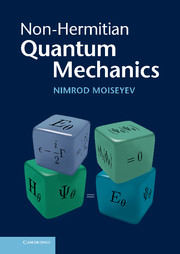Book contents
- Frontmatter
- Contents
- Preface
- 1 Different formulations of quantum mechanics
- 2 Resonance phenomena in nature
- 3 Resonances from Hermitian quantum-mechanical calculations
- 4 Resonances from non-Hermitian quantum mechanical calculations
- 5 Square integrable resonance wavefunctions
- 6 Bi-orthogonal product (c-product)
- 7 The properties of the non-Hermitian Hamiltonian
- 8 Non-Hermitian scattering theory
- 9 The self-orthogonality phenomenon
- 10 The point where QM branches into two formalisms
- Index
6 - Bi-orthogonal product (c-product)
Published online by Cambridge University Press: 03 May 2011
- Frontmatter
- Contents
- Preface
- 1 Different formulations of quantum mechanics
- 2 Resonance phenomena in nature
- 3 Resonances from Hermitian quantum-mechanical calculations
- 4 Resonances from non-Hermitian quantum mechanical calculations
- 5 Square integrable resonance wavefunctions
- 6 Bi-orthogonal product (c-product)
- 7 The properties of the non-Hermitian Hamiltonian
- 8 Non-Hermitian scattering theory
- 9 The self-orthogonality phenomenon
- 10 The point where QM branches into two formalisms
- Index
Summary
This chapter is divided into several sections which together represent one of the fundamental concepts in the non-Hermitian formalism of quantum mechanics (NH QM). First we discuss the need to replace the inner product used in the standard (Hermitian) formalism of quantum mechanics by another construct which was termed the c-product by Moiseyev, Certain and Weinhold in 1978. Unlike the standard situation where the eigenfunctions (eigenvectors) of an Hermitian operator (matrix) form a complete set which can be used to expand a wavepacket which describes the system at a given time, in NH QM it might happen that the eigenfunctions make up an incomplete set since several (usually two) eigenfunctions (eigenvectors) coalesce to generate a self-orthogonal state. We need completeness and closure relations in order to develop, for example, perturbation theory and scattering theories for non-Hermitian Hamiltonians and in order to be able to solve the Schrödinger equation by numerical methods. Therefore, the second section of this chapter is devoted to the completeness of the spectrum in NH QM. Other aspects of the non-Hermitian formalism which stem from this issue deal with the advantages of using a non-Hermitian formalism for a time-dependent description of a decaying system as well as its application to time-periodic systems. Accordingly, the discussion in one of the sections will encompass the propagation of wavepackets in non-Hermitian quantum mechanics whereas another will elaborate on the benefits of the formalism for the description of the interaction of matter with intense laser radiation.
- Type
- Chapter
- Information
- Non-Hermitian Quantum Mechanics , pp. 174 - 210Publisher: Cambridge University PressPrint publication year: 2011
- 1
- Cited by



